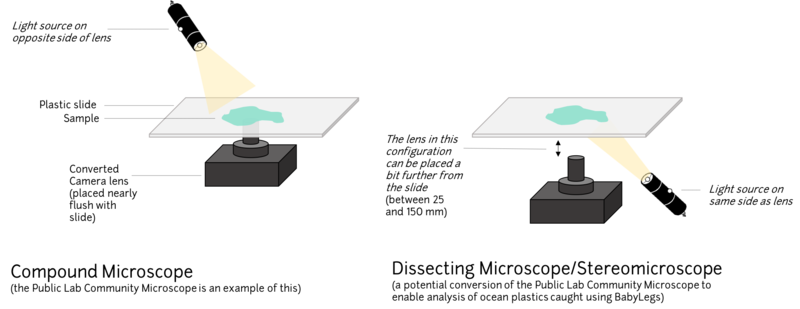@maxliboiron recently made a great post about using BabyLegs- a research trawl (net system) for monitoring plastic pollution, especially microplastics, in surface water. You can reference this page to learn how to build and deploy the BabyLegs trawl and how to process your samples. In the wiki page about microplastics analysis, she mentions the need for a dissecting microscope, which is different than a compound microscope.
Public Lab is curious if the community microscope, which is a compound microscope in its present state, can be converted into a dissecting microscope for this use. I've made a diagram below, illustrating what I believe to be the conversion process. I haven't tried it out myself but I encourage others to do so and let us know how it goes!

Read more about the difference between the compound and dissecting microscope here.
This looks great, and AWESOME diagram! @maxliboiron do you think we have to flip the dissecting scope so that the materials can be on the same side of the slide as the camera, and don't fall off? i.e. the camera looks down at them?
Or do you think we'd be able to focus through the bottom of a glass or plastic slide or container to view them from below?
Thanks!
On Wed, Aug 8, 2018 at 5:09 PM \<notifications@publiclab.org> wrote:
Is this a question? Click here to post it to the Questions page.
Reply to this comment...
Log in to comment
A bit more info on this back at this question from some months back: https://publiclab.org/questions/stevie/12-08-2017/could-the-raspberry-pi-microscope-be-used-for-looking-at-microplastics-found-in-ocean-water
Reply to this comment...
Log in to comment
In a perfect world, you wouldn't be looking through plexi at your marine plastic because plexi has characteristics of plastic (scratches, reflection, etc) that might obfuscate or layer on what you're trying to analyze. Sometimes the clue that you're looking at a plastic and not paper, a shell, or an exoskeleton is very minute, and I'd worry that for tricky cases the plexi (or even glass) between the viewer and the plastic would sway visual interpretation. So in short, it would be best to flip it, but also to have the lens and the stage farther apart, as the diagram shows.
This image shows our two store-bought scopes (compound on the left, which we rarely use, and the dissecting scope on the right, where you can see light coming from below the stage and above, as well as the relative distance between the lens and the stage).
Reply to this comment...
Log in to comment
Thanks for the reply Max! So, what we are really looking at for conversion is adding a secondary light source as seen in the image below.
Reply to this comment...
Log in to comment
Looks about right to me.
Reply to this comment...
Log in to comment
OK, i was able to build one using @jiteovien's diagram; I remember at the Nueva School before MakerFaire last year, some of the kids were able to make a low-magnification microscope by not flipping the lens (unlike the #community-microscope) but simply by spacing it further away from the sensor. (you can see a photo of the workshop here and an update about it here)
Here's a photo of what they did:
At first I thought I had to remove the lens and place it further away, but after struggling for a while, I realized I could just unscrew it /somewhat/ but not anywhere near all the way.
It worked! Here's a photo of the setup. Like @jiteovien proposed, I just put the camera above, facing down through the hole, rather than looking up through it.
It took a LOT of light, so we may need to think how we can boost light in a more efficient way than using a ton of gooseneck LED lights. But I think it compares well with photos of microplastics from the #babylegs page.
Here's a photo of an SD card with a crude scale bar:
Compare to Max's photo from the #babylegs page:
@maxliboiron, what do you think? It's not very crisp, but in terms of scale, does this work?
If we need a lot more resolution for this to be useful, we can use one of the nicer cameras from the Plus kit.
Is this a question? Click here to post it to the Questions page.
Yes!! This will work for plastic forensics! Especially as the light comes from above rather than below (most plastics are opaque). The resolution and magnification are fine. Once things get too magnified, it's hard to tell plastic from other matter without significant experience. So this is perfect!
Reply to this comment...
Log in to comment